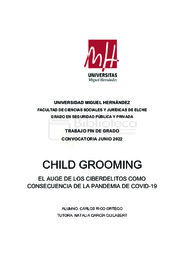Por favor, use este identificador para citar o enlazar este ítem:
https://hdl.handle.net/11000/28252Registro completo de metadatos
| Campo DC | Valor | Lengua/Idioma |
|---|---|---|
| dc.contributor.advisor | García Guilabert, Natalia | - |
| dc.contributor.author | Rico Ortego, Carlos | - |
| dc.contributor.other | Departamentos de la UMH::Ciencia Jurídica | es_ES |
| dc.date.accessioned | 2022-11-07T08:13:26Z | - |
| dc.date.available | 2022-11-07T08:13:26Z | - |
| dc.date.created | 2022-06-02 | - |
| dc.identifier.uri | https://hdl.handle.net/11000/28252 | - |
| dc.description.abstract | La digitalización de todo lo que nos rodea y el imparable desarrollo de las tecnologías de la información y de la comunicación han ocasionado profundos cambios en la sociedad incluso en la forma de perpetrar delitos. Y es que, más allá de todas las ventajas que presta el entorno digital e informático, el mismo también constituye un escenario en el que llevar a cabo prácticas fraudulentas o la comisión de ciertas infracciones tipificadas como delitos en el Código Penal. Entre todas ellas destaca el ciberacoso sexual de menores, o delito de child grooming. Se trata de una práctica desarrollada en la red, y que está destinada a contactar con un menor para concertar un encuentro con el mismo y realizar actos sexuales, siempre y cuando a tal contacto se le acompañen actuaciones de carácter material, que faciliten el acercamiento al menor. A lo largo de este trabajo, se efectuará un estudio sistemático que aborde este fenómeno y su eventual crecimiento durante la pandemia de Covid-19 y los sucesivos confinamientos, como consecuencia de un posible cambio en las prácticas y costumbres de la población. | es_ES |
| dc.description.abstract | The digitization of everything around us and the unstoppable development of new information and communication technologies have caused profound changes in society, including in the way crimes are perpetrated. And, beyond all the advantages provided by the digital and computer environment, it also constitutes a scenario in which to carry out fraudulent practices or the commission of certain infractions classified as crimes in the Criminal Code. Among all of them, the sexual cyberharassment of minors, or the crime of child grooming, stands out. It is a practice developed in the network, and that is intended to contact a minor to arrange a meeting with him and perform sexual, as long as such contact is accompanied by actions of a material nature, which facilitate the approach to the minor. Throughout this work, a systematic study will be carried out to address this phenomenon and its eventual growth during the Covid-19 pandemic and the successive confinements, as a result of a possible change in the practices and customs of the population. | es_ES |
| dc.format | application/pdf | es_ES |
| dc.format.extent | 35 | es_ES |
| dc.language.iso | spa | es_ES |
| dc.publisher | Universidad Miguel Hernández de Elche | es_ES |
| dc.rights | info:eu-repo/semantics/openAccess | es_ES |
| dc.rights | Attribution-NonCommercial-NoDerivatives 4.0 Internacional | * |
| dc.rights.uri | http://creativecommons.org/licenses/by-nc-nd/4.0/ | * |
| dc.subject | child grooming | es_ES |
| dc.subject | ciberacoso | es_ES |
| dc.subject | menores | es_ES |
| dc.subject | Covid | es_ES |
| dc.subject | pandemia | es_ES |
| dc.subject.other | CDU::3 - Ciencias sociales::34 - Derecho::343 - Derecho penal. Delitos | es_ES |
| dc.title | Child Grooming. El Auge de los ciberdelitos como consecuencia de la pandemia de Covid-19 | es_ES |
| dc.type | info:eu-repo/semantics/bachelorThesis | es_ES |

Ver/Abrir:
Child Grooming - TFG - Carlos Rico Ortego.pdf
1,21 MB
Adobe PDF
Compartir:
 La licencia se describe como: Atribución-NonComercial-NoDerivada 4.0 Internacional.
La licencia se describe como: Atribución-NonComercial-NoDerivada 4.0 Internacional.
.png)